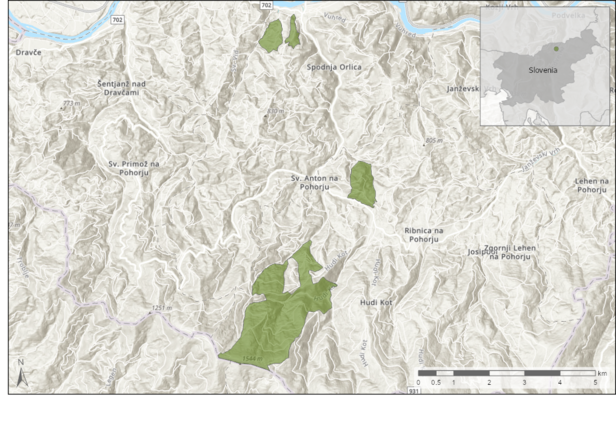
C6 Pahernik Forest
A case from Slovenia

Basic information of Pahernik forest according to the last forest management plan (2014–2023).
| Forest community | – Beech forest with white wood-rush Luzulo–Fagetum (66 %) – Fir forest with round-leaved bedstraw Galio rotundifolii–Abietetum (23 %) – Spruce forest with wavy hairgrass Avenello flexuosae–Piceetum (3.5 %) – Spruce forest with great wood-rush Luzulo sylvaticae–Piceetum (3 %) – Beech forest with hard fern Blechno–Fagetum (3 %) – Forests of valuable broadleaved trees on non-carbonate bedrock Dryopterido affinis–Aceretum pseudoplatani (1 %) on ravines and slopes – Fir forest with Long-Leaved Fork-Moss Paraleucobryo–Abietetum (0.3 %) – Grey alder forest with balm-leaved archangel Lamio orvalae–Alnetum incanae (0.2 %) |
| Total forest area | 570 ha |
| Main management types | Freestyle silvicultural system following natural principles (from single and group selection to irregular shelterwood) |
| Total volume | 453 m³/ha |
| Annual growth | 10.8 m³/ha |
| Annual use | 8 m³/ha |
| Deadwood (standing and lying) | 11.6 m³/ha |
| Altitude | Between 370–1542 m |
| Ownership | Pahernik Foundation |
| Geology | Lower part: metamorphic stones (gneiss, phyllite) Upper part: magmatic stones (tonalite, dacite) Soils are mostly acid brown soils (district cambisol) |
| Protected area | 14.3 ha are ecocells |
| Nature protection area (Natura 2000) | 331 ha |
| Main function – biodiversity conservation | 73 ha |
| Main function – Protective (protection of forest stands and soil) | 311 ha |
| Main function – social | Protection: protection of forest roads Hudi kot – Kralj and road on Pungart Aesthetic: around chapels and church, Pahernik spruce and stone sculptures Educational: on paths leading through educational objects (forest) |
